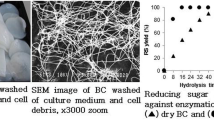Abstract
Bacterial cellulose (BC) membranes covalently dyed with Remazol Brilliant Blue R (RBB) was used as an advantageous chromogenic substrate for the detection and measurement of the activity of cellulolytic enzymes. The covalent coupling was confirmed using nuclear magnetic resonance techniques. The BC membranes, both dyed and non-dyed, were saccharified with a 1:1 combination of (endoglucanases + cellobiohydrolases):β-glucosidase. Native BC required a lower enzyme loading for the release of 2 mg of reducing sugars. A higher loading was required for the RBB-BC, which, in turn, was more easily hydrolysed than both the native and the RBB-Whatman n.1 filter paper standard substrates. The enzymatic hydrolysis kinetics of RBB-BC confirmed the correlation between the release of reducing sugars and dyed products as indicated by the Pearson’s correlation coefficient (r = 0.9950). Thin layer chromatography was used to monitor glucose and traces of cellobiose as the main hydrolysis products from native BC, whereas RBB-cellobiose was markedly dominant over RBB-glucose in the case of RBB-BC hydrolysis.







Similar content being viewed by others
References
Amano Y, Nozaki K, Kanda T, Bowling AJ, Saxena IM, Brown Jr MR (2004) Analysis of cellulase action using bacterial cellulose with unique structure. American Chemical Society 222th Meeting 227:U-306-cell171
Brown AJ (1886) On an acetic acid ferment which forms cellulose. J Chem Soc 49:432–439
Brown Jr RM (2011) Microbial cellulose: a new resource for wood, paper, texties, food and specialty products. The University of Texas at Austin. http://www.botany.utexas.edu/facstaff/facpages/mbrown/. Accessed March 2011
Cavaco-Paulo A, Almeida L (1994) Cellulase hydrolysis of cotton cellulose: the effects of mechanical action, enzyme concentration and dyed substrates. Biocatal Biotransform 10(1–4):353–360. doi:10.3109/10242429409065244
Corti GS, Botaro VR, Gil LF, Gil RPF (2004) Estudo da Capacidade de Complexação de Íons Cu + 2 em Solução Aquosa Usando Celulose Modificada com Anidrido Succínico e com Poliaminas. Polimeros 14(005):313–317
Czaja W, Krystynowicz A, Bielecki S, Brown RM Jr (2006) Microbial cellulose: the natural power to heal wounds. Biomaterials 27(2):145–151
Czaja WK, Young DJ, Kawecki M, Brown MR Jr (2007) The future prospects of microbial cellulose in biomedical applications. Biomacromolecules 8(1):1–12
Decker SR, Adney WS, Jennings E, Vinzant TB, Himmel ME (2003) Automated filter paper assay for determination of cellulase activity. Appl Biochem Biotech 105–108:689–703
Fernley HN (1963) The use of reactive dyestuffs in enzymology: new substrates for cellulolytic enzymes. Biochem J 87(1):90–95
Fontana JD, Desouza AM, Fontana CK, Torriani IL, Moreschi JC, Gallotti BJ, Desouza SJ, Narcisco GP, Bichara JA, Farah LFX (1990) Acetobacter cellulose pellicle as a temporary skin substitute. Appl Biochem Biotech 24–5:253–264
Ghose TK (1987) Measurement of cellulase activities. Pure Appl Chem 59(2):257–268
Grande CJ, Torres FG, Gomez CM, Troncoso OP, Canet-Ferrer J, Martínez-Pastor J (2009) Development of self-assembled bacterial cellulose-starch nanocomposites. Mater Sci Eng C 29(4):1098–1104
Gromet-Elhanan Z, Hestrin S (1963) Synthesis of cellulose by Acetobacter xylinum—VI. Growth on citric acid-cycle intermediates. J Bacteriol 85:284–292
Hayashi N, Sugiyama J, Okano T, Ishihara M (1997) The enzymatic susceptibility of cellulose microfibrils of the algal-bacterial type and the cotton-ramie type. Carbohyd Res 305(2):261–269
Hsieh YC, Yano H, Nogi M, Eichhorn S (2008) An estimation of the young’s modulus of bacterial cellulose filaments. Cellulose 15(4):507–513. doi:10.1007/s10570-008-9206-8
Itzhaki RF, Gill DM (1964) A micro-biuret method for estimating proteins. Anal Biochem 9(4):401–410. doi:10.1016/0003-2697(64)90200-3
Lai TE, Pullammanappallil PC, Clarke WP (2006) Quantification of cellulase activity using cellulose-azure. Talanta 69(1):68–72
Leisola M, Linko M (1976) Determination of the solubilizing activity of a cellulase complex with dyed substrates. Anal Biochem 70(2):592–599
Luo X, Zhu JY (2011) Effects of drying-induced fiber hornification on enzymatic saccharification of lignocelluloses. Enzyme Microbial Technol 48(1):92–99. doi:10.1016/j.enzmictec.2010.09.014
Lynd LR, Weimer PJ, Zyl WHv, Pretorius IS (2002) Microbial cellulose utilization: fundamentals and Biotechnology. Microbiol Mol Biol R 66(3):506–577. doi:10.1128/MMBR.66.3.506-577.2002
Matsumura H, Sugiyama J, Glasser WG (2000) Cellulosic nanocomposites. I. Thermally deformable cellulose hexanoates from heterogeneous reaction. J Appl Polym Sci 78 (13):2242-2253. doi:10.1002/1097-4628(20001220)78:13<2242::aid-app20>3.0.co;2-5
Miller GL (1959) Use of dinitrosalicylic acid reagent for determination of reducing sugar. Anal Chem 31(3):426–428
Nge TT, Sugiyama J, Bulone V (2010) Bacterial cellulose-based biomimetric composites. In: Magdy Elnasher (ed) Biopolymers. InTech. http://www.intechopen.com/books/biopolymers/bacterialcellulose-based-biomimetic-composites. Accessed Sept 2010
Pecoraro É, Manzani D, Messaddeq Y, Ribeiro SJL (2007) Chapter 17—bacterial cellulose from glucanacetobacter xylinus: preparation, properties and applications. In: Monomers, polymers and composites from renewable resources. Elsevier, Amsterdam, pp 369–383
Sanchavanakit N, Sangrungraungroj W, Kaomongkolgit R, Banaprasert T, Pavasant P, Phisalaphong M (2006) Growth of human keratinocytes and fibroblasts on bacterial cellulose film. Biotechnol Prog 22(4):1194–1199. doi:10.1021/bp060035o
Shibazaki H, Kuga S, Okano T (1997) Mercerization and hydrolysis of bacterial cellulose. Cellulose 4:75–87
Wang QQ, He Z, Zhu Z, Zhang YHP, Ni Y, Luo XL, Zhu JY (2012) Evaluations of cellulose accessibilities of lignocelluloses by solute exclusion and protein adsorption techniques. Biotechnol Bioeng 109(2):381–389. doi:10.1002/bit.23330
Wiederschain G (2007) Polysaccharides. Structural diversity and functional versatility. Biochem 72(6):675. doi:10.1134/s0006297907060120
Yu X, Atalla RH (1998) A staining technique for evaluating the pore structure variations of microcrystalline cellulose powders. Powder Technol 98(2):135–138. doi:10.1016/s0032-5910(98)00024-2
Zeikus JG, Ng TK (1983) Continuous spectrophotometric assay of microbial cellulase. United States Patent 4403032
Acknowledgments
The authors would like to thank the National Council for Scientific and Technological Development (CNPq), Coordination for the Improvement of Higher Education Personnel (CAPES) and the Araucaria Foundation from SETI-PR.
Author information
Authors and Affiliations
Corresponding author
Rights and permissions
About this article
Cite this article
Tiboni, M., Grzybowski, A., Passos, M. et al. The use of dyed bacterial cellulose to monitor cellulase complex activity. Cellulose 19, 1867–1877 (2012). https://doi.org/10.1007/s10570-012-9787-0
Received:
Accepted:
Published:
Issue Date:
DOI: https://doi.org/10.1007/s10570-012-9787-0




